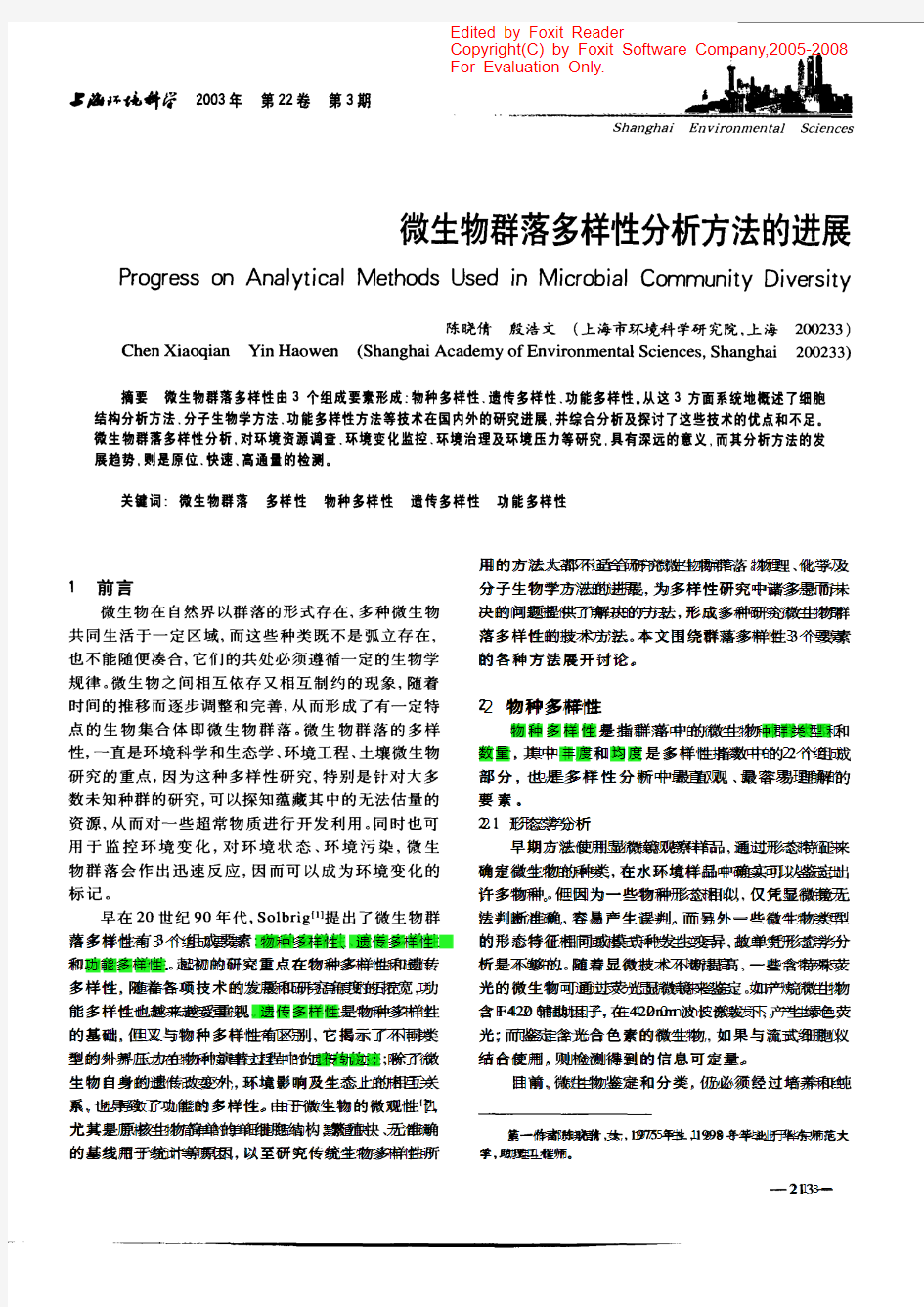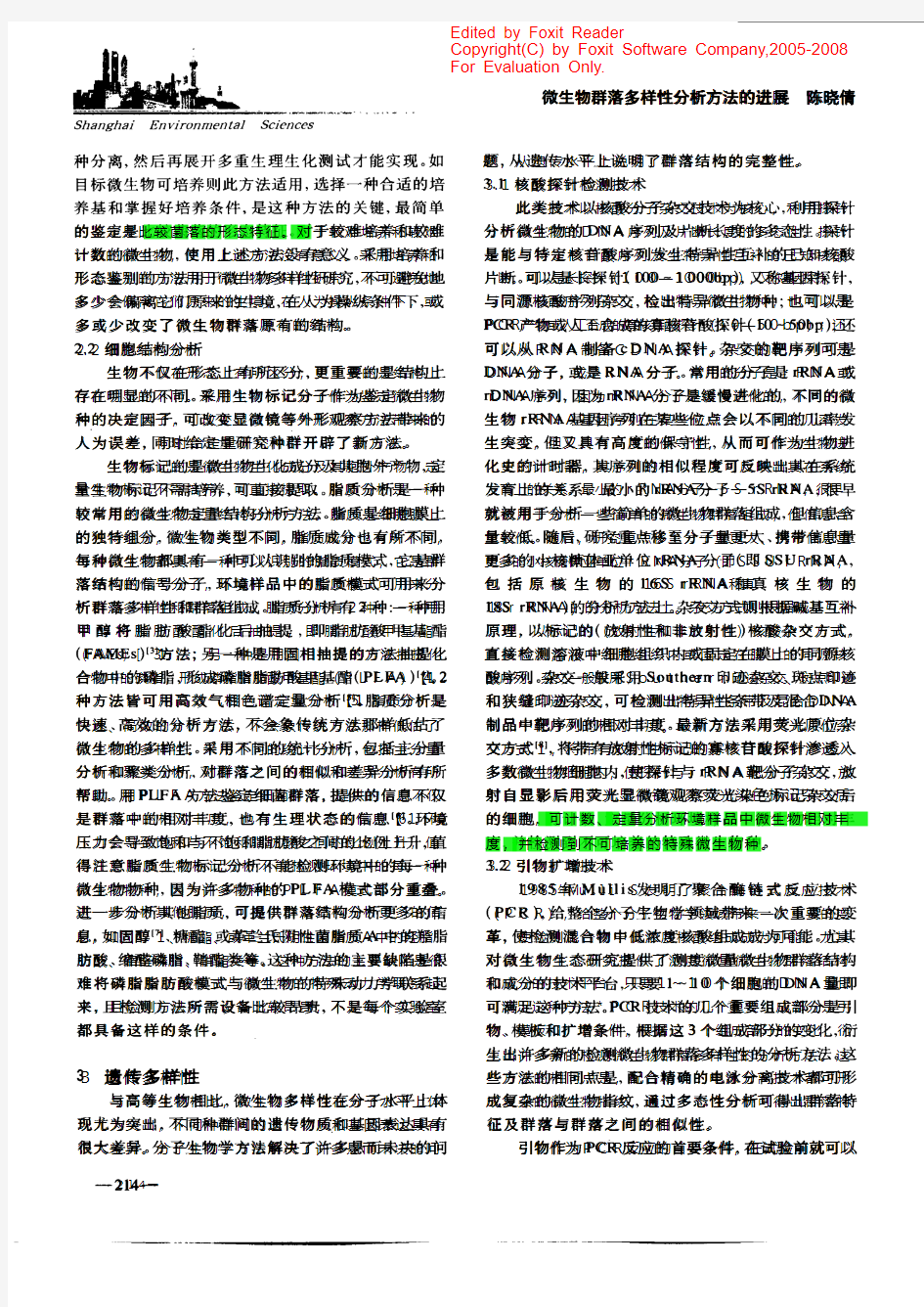

(5)高通量测序:环境微生物群落多样性分析 微生物群落多样性的基本概念 环境中微生物的群落结构及多样性和微生物的功能及代谢机理是微生物生态学的研究 热点。长期以来,由于受到技术限制,对微生物群落结构和多样性的认识还不全面, 对微生物功能及代谢机理方面了解的也很少。但随着高通量测序、基因芯片等新技术 的不断更新,微生物分子生态学的研究方法和研究途径也在不断变化。第二代高通量 测序技术(尤其 是Roche 454高通量测序技术)的成熟和普及,使我们能够对环境微生物进行深度测序,灵 敏地探测出环境微生物群落结构随外界环境的改变而发生的极其微弱的变化,对于我 们研究微生物与环境的关系、环境治理和微生物资源的利用以及人类医疗健康有着重 要的理论和现实意义。 在国内,微生物多样性的研究涉及农业、土壤、林业、海洋、矿井、人体医学等诸多领域。以在医疗领域的应用为例,通 过比较正常和疾病状态下或疾病不同进程中人体微生物群落的结构和功能变化,可以 对正常人群与某些疾病患者体内的微生物群体多样性进行比较分析,研究获得人体微 生物群
落变化同疾病之间的关系;通过深度测序还可以快速地发现和检测常见病原及新发传 染病病原微生物。研究方法进展 环境微生物多样性的研究方法很多,从国内外目前采用的方法来看大致上包括以下四 类:传统的微生物平板纯培养方法、微平板分析方法、磷脂脂肪酸法以及分子生物学 方法等等。 近几年,随着分子生物学的发展,尤其是高通量测序技术的研发及应用,为微生物分 子生态学的研究策略注入了新的力量。 目前用于研究微生物多样性的分子生物学技术主要包 括:DGGE/TGGE/TTGE 、 T-RFLP 、SSCP、FISH 、印记杂交、定量 PCR、基因芯片等。 DGGE 等分子指纹图谱技术,在其实验结果中往往只含有数十条条带,只能反映出样品中少数 优势菌的信息;另一方面,由于分辨率的误差,部分电泳条带中可能包含不只一种 16S rDNA 序列,因此要获悉电泳图谱中具体的菌种信息,还需 对每一条带构建克隆文库,并筛选克隆进行测序,此实验操 作相对繁琐;此外,采用这种方法无法对样品中的微生物做 到绝对定量。生物芯片是通过固定在芯片上的探针来获得微
安庆师范学院本科毕业(学位)论文 姓名:王婷婷 年级: 2 0 0 7级 专业:环境科学 论文题目:微生物多样性对植物 群落影响的研究进展 完成日期:2011年4月27日 指导老师:潘少兵 安庆师范学院资源环境学院 二O一一年四月二十七日
微生物多样性对植物群落影响的研究进展 作者:王婷婷指导老师:潘少兵 (安庆师范学院资源环境学院安徽安庆246011) 摘要:土壤是微生物的主要存在场所,它承载了大部分生命的基因多样性。微生物群落在各种生态进程中具有重要作用,但是对于微生物多样性与执行生态功能能力的联系却研究的很有限。这篇文章以微生物多样性在植物群落方面的作用为基础,探讨微生物群落在执行生态功能中的冗余现象。 关键词:微生物多样性;功能冗余;植物多样性 Advancement of Effect of Microbial Diversity on Plant Diversity Autor:Wang Tingting Instructor: Pan Shaobing (School of Resources and environmental science,Anqing Teachers’College,Anqing 246011,Anhui) Abstract: Microbes are abundant in soil and comprise a large portion of Life's genetic diversity. Soil microbes play key roles in a large number of important ecosystem process- es. But the relativity between soil microbial diversity and their ecological functions is still poorly understood. Here we approach the functional redundances during soil microb- es influencing the ecological functions based on the various roles that they play in plant diversity. Key words:microbial diversity, functional redundances, plant diversity 引言: 土壤是微生物的主要存在场所,微生物在土壤养分转化与腐殖质形成过程中有着非常重要的作用。土壤生态系统是保证动植物生存、农业健康、持续发展的基础[1],对全球的生态环境变化有着深远的影响。土壤微生物群落是土壤中的活性组分, 包括细菌、真菌、放线菌和原生动物、病毒和小型藻类[2],每克土壤中栖息着大约100 亿个微生物[3]。土壤微生物群落对全球生态系统功能如养分转化、有机物的分解、土壤基本结构的维持、
微生物多样研究中的—β多样性分析概述
一、β-多样性分析介绍 1. β(Beta)Diversity: 是对不同样品/不同组间样品的微生物群落构成进行比较分析。 ?β多样性分析前的数据“来源”: 1)OTUs的丰度信息表; 2)OTUs之间的系统发生关系, 计算Unweighted Unifrac及Weighted Unifrac距离。 ?通过多变量统计学方法主成分分析(PCA,Principal Component Analysis),主坐标分析(PCoA,Principal Co-ordinates Analysis),非加权组平均聚类分析(UPGMA,Unweighted Pair-group Method with Arithmetic Means)等分析方法,从中发现不同样品(组)间的差异。
2. PCA & PCoA分析 ?主成分分析(PCA)是多变量统计学中最为人熟知的分析方法,它通过线性变换,将原始的高维数据投影至少量新合成的变量(即主成分),从而简化数据结构,展现样品的自然分布。 ?主成分分析不考虑原始变量之间可能存在的相互关系,并且是基于欧式距离评价样品之间的相似度。 ?多维尺度分析与主成分分析类似,但是它可以采用任何距离评价样品之间的相似度。主坐标分析(Principal coordinates analysis,PCoA)是经典的多维尺度分析方法。
3.UniFrac距离 ?由于微生物极其多样,不同微生物彼此之间的系统发育关系往往千差万别,仅仅将群落中不同微生物成员视为相互独立的变量显然并不合理。 ?因此,在比较不同群落样品之间的差异时,需要考虑两个群落成员之间的系统发育关系是否相似。 ?基于这个思想,计算微生物群落样品间距离的UniFrac距离应运而生,通过比较两个群落各自独有的微生物成员之间系统发育关系的远近,更为客观地反映两个群落样品之间的相似程度。
生物多样性 2012, 20 (5): 572–580 Doi: 10.3724/SP.J.1003.2012.10129 Biodiversity Science http: //https://www.doczj.com/doc/297529186.html, —————————————————— 收稿日期: 2012-06-13; 接受日期: 2012-08-10 基金项目: 国家自然科学基金重点项目(30930005) ? 通讯作者 Author for correspondence. E-mail: guold@https://www.doczj.com/doc/297529186.html, 中国微生物物种多样性研究进展 郭良栋* (中国科学院微生物研究所真菌学国家重点实验室, 北京 100101) 摘要: 微生物是分布最为广泛的生命形式, 几乎分布到地球上的所有生境, 具有丰富的物种多样性。我国地域辽阔, 跨越热带至寒温带, 气候条件多样, 地理环境与生态系统类型复杂, 是世界上生物多样性最丰富的国家之一。我国已开展了大量微生物多样性研究, 并证实我国多样的生境蕴藏着丰富的微生物物种多样性。目前我国已报道真核微生物(菌物)约14,700种, 其中包括真菌约14,060种、卵菌约300种、黏菌约340种, 而真菌中有药用菌473种、食用菌966个分类单元。特别是近年来通过免培养的分子生物学技术发现我国存在丰富的原核微生物多样性。本文概述了传统方法和现代分子生物学技术在我国原核微生物(古菌、细菌)和真核微生物(真菌、卵菌、黏菌)物种多样性研究的最新进展。 关键词: 真核微生物, 原核微生物, 物种多样性, 培养方法, 分子技术 Progress of microbial species diversity research in China Liangdong Guo * State Key Laboratory of Mycology, Institute of Microbiology, Chinese Academy of Sciences, Beijing 100101 Abstract: Microbes with rich species and genetic diversity are widely distributed throughout various habitats in the world. China possesses a variety of climate zones, geographic environments, and complex ecosystems, which play a large role shaping the complex biodiversity of this country. Microbial diversity has been widely studied and well documented by Chinese scientists. For example, a total of ca. 14,700 eukaryotic microbe species have been recorded, including ca. 14,060 fungi, ca. 300 oomycetes, and ca. 340 slime molds. Within the Fungi, there have been 473 medicinal fungal species and 966 edible fungal taxa recorded. However, re-cent studies have documented much high species diversity of prokaryotic microbes using molecular tech-niques, which have greatly promoted the study level of microbial diversity in China. This review paper sum-marizes recent research progress of microbial (i.e., archaea, bacteria, fungi, oomycetes, and slime molds) di-versity in China based on traditional and molecular techniques. Key words: eukaryotic microbe, prokaryotic microbe, species diversity, cultivation method, molecular technique 微生物是分布最为广泛的生命形式, 几乎分布到地球上的所有生境, 可利用各种有机化合物、无机盐等作为能源, 在有氧或无氧条件下, 在寒冷的极地、高达100℃的热泉或高盐碱度等极端环境中生活。微生物具有丰富的物种和遗传多样性, 并以高度的变异性适应不同的生境。作为生态系统中的重要组分, 微生物在自然界的物质与能量循环、生态系统的演替以及生物多样性的维持中发挥重要的生态功能。微生物与人类的生活休戚相关, 在直 接或间接地为人类提供了极其丰富的物质资源的同时, 也为人类带来了巨大危害。 Woese 和Fox(1977)以核糖体RNA(rRNA)的小亚基(原核生物的16S 、真核生物的18S 基因)序列为依据, 提出了独立于真细菌(Eubacteria)和真核生物(Urkaryotes)之外的第三种生命形式——古菌(Archaea), 认为它和真核生物以及真细菌是从一个具有原始遗传机制的共同祖先分别进化而来。随后Woese 等(1990)提出了三域(Domain)分类系统, 将
第一章绪论 课程主要内容: 1、微生物学研究技术发展 2、微生物材料的准备 3、微生物研究中的物理化学方法基础 4、微生物的观察与微生物分析法 5、细胞破碎方法及亚细胞物质分离 6、微生物育种技术 7、固相化技术与生物传感器 8、免疫学技术 9、微生物学研究的分子生物学技术 微生物学研究技术发展: 微生物学是整个生物学中第一门具有一套自己独特操作技术的学科,其技术的发展主要包括: 1、显微镜术和制片染色技术 2、消毒灭菌技术和无菌操作技术 3、纯种分离和克隆化技术 4、合成培养基技术;选择性和鉴别性培养技术 5、突变型标记和筛选技术;深层液体培养技术 6、菌种保藏技术 7、原生质体制备和融合技术 8、各种DNA重组技术等 第二章微生物材料的准备 第一节灭菌、消毒、除菌与无菌操作 掌握知识要点: 原理、方法、生物活性物质的除菌 无菌操作:意识、个人卫生、环境卫生、灭菌、接种等操作、保存 一、几个基本概念 控制害菌的措施: 1)杀灭法: ○1灭菌:彻底杀灭(杀菌、溶菌)——一切微生物 ○2消毒:部分杀灭——仅杀灭病原菌 2)抑制法: ○1防腐:抑制霉腐微生物 ○2化疗:抑制宿主体内的病原菌 1、灭菌:采用强烈的理化因素使任何物体内外部的一切微生物永远丧失其生长繁殖能力的 措施。例如:高温灭菌、辐射灭菌等。 2、消毒:消除毒害,即传染源、致病菌。一种采用较温和的理化因素,仅杀死物体表面或 内部一部分对人体或动、植物有害的病原菌,而对被消毒的对象基本无害的措施。例如:
常用的对皮肤、水果、饮用水进行药剂消毒的方法 对啤酒、牛奶、果汁和酱油等进行消毒处理的巴氏消毒法 1)巴氏消毒法(pasteurization) 2)煮沸消毒法 采用在100℃下煮沸数分钟的方法,一般用于饮用水的消毒。 3、防腐:利用某种理化因素完全抑制霉腐微生物的生长繁殖,即通过抑菌作用防止食品、生物制品等对象发生霉腐的措施。 防腐的方法: ①低温:利用4℃以下的各种低温(0,-20,-70,-196℃)保藏食物、生化试剂、 生物制品或菌种等。 ②缺氧:可采用抽真空、充氮或二氧化碳、加入除氧剂等方法来有效防止食品和粮食 等的霉腐、变质而达到保鲜的目的。 除氧剂的种类很多,是由主要原料铁粉再加上一定量的辅料和填充剂制成,对糕点等含水量较高的新鲜食品有良好的保鲜功能。 ③干燥:采用晒干、烘干或红外线干燥等方法对粮食、食品等进行干燥保藏,是最常 见的防止霉腐的方法; 在密封条件下,用生石灰、无水氯化钙、无氧化二磷、氢氧化钾(或钠)或硅胶等作为吸湿剂,也可很好的达到食品、药品和器材等长期防霉腐的目的。 ④高渗:通过盐腌和糖渍等高渗措施来保存食物,是在民间早就流传的有效防霉腐的 方法。 ⑤高酸度:在我国和韩国等具有悠久历史的泡菜,就是利用乳酸菌的厌氧发酵使新鲜 蔬菜产生大量乳酸,借这种高酸度而达到抑制杂菌和防霉腐的目的。 ⑥高醇度:用白酒或黄酒保存食品,在我国有悠久传统,如:醉蟹、醉麸、醉笋和黄 泥螺等产品,都是特色风味食品。 ⑦加防腐剂:在有些食品、调味品、饮料、果汁或工业器材中,可加入适量的防腐剂 或防霉剂来达到防霉腐的目的,如: 用苯甲酸来使酱油防腐; 用尼泊金作墨汁防腐剂; 用山梨酸、脱氢醋酸作化妆品防腐剂; 用二甲基延胡索酸(DMF)作食品、饲料的防腐剂。 4、化疗——化学治疗 利用具有高度选择毒力即对病原菌具高度毒力而对宿主基本无毒的化学物质来抑制宿主体内病原微生物的生长繁殖,借以达到治疗该宿主传染病的一种措施。 用于化学治疗目的的化学物质称化学治疗剂,包括磺胺类等化学合成药物、抗生素、生物药物素和若干中草药中有效成分等。 要点: 1.灭菌:利用物理、化学方法杀死物体表面、内部全部的微生物。 2.消毒:杀死物体表面或内部有害微生物或使其钝化,使致病微生物不致病。 3.除菌:利用物理方法除去物体表面的微生物。
变性梯度凝胶电泳(PCR-DGGE) 普通的聚丙烯酰胺凝胶电泳只能通过片段大小不同在同一浓度的胶上电泳迁移率不同而分离不同的DNA片段,对于片段大小接近或相同的DNA片段无法做到有效地分离;DGGE(denaturing gradient gel electrophoresis) 即变性梯度凝胶电泳,是利用DNA在不同浓度的变性剂中解链行为的不同而导致电泳迁移率发生变化,从而将片段大小相同而碱基组成不同的DNA片段分开。 DGGE作为一种成熟的分子生物学技术被广泛应用于环境科学(土壤、海洋、河流、冰川、淤泥等)、医学(各种疾病治疗前后,病变部位微生物的差异)、人体(鼻咽、口腔、黏膜、肠道)等领域进行微生物多样性分析。 实验流程图: 实验结果 实验结果包括以下内容 1 引物设计 以下是DGGE中常用的引物,我们将根据客户的不同需求,进行针对性的引物设计。 引物序列(5’-3’)
细菌 16S V3 区扩 增引物 357-F-GC CGCCCGCCGCGCGCGGCGGGCGGGGCGGGG GCACGGGGGGCCTACGGGAGGCAGCAG 518r ATTACCGCGGCTGCTGG 引物 序列(5’-3’) 真核 18S V1-3区扩增引物 Euk1A CTGGTTGATCCTGCCAG EukA516r-GC CGCCCGGGGCGCGCCCCGGGCGGGGCGGGGGCA CGGGGGGACCAGACTTGCCCTCC 2 基因组DNA 抽提电泳检测图 针对客户的样本来源不同,我们针对性优化不同的基因组抽提方法,已达到提取效果最佳。 说明:1-8为样本所抽提基因组DNA,上样量3uL;M 为1kb Marker 上数第一条带为8 kb,中间的亮带为3kb,浓度为30ng/uL,其余为10 ng/uL。 3 目的片段PCR 检测 说明:1-8为样本,负为负对照(说明我们的实验没有污染,这对分子实验是至关重要的),上样量为5uL;M 为DL2000 Marker,上样量3uL。其中亮带为20ng/uL,其余为10 ng/uL。 Reconditioning PCR: 第一轮PCR 产物将会作为新的模板再进行少数循环的第二轮PCR 扩增,这叫做“Reconditioning PCR”。由于在“ Reconditioning PCR”的过程中引物和模板之
姓名:崔靖璞学号:2010212802 专业:生物科学 微生物多样性研究进展 摘要:微生物资源丰富,开发潜力巨大,是生命科学发展的主要动力之一.本文介绍了几种常用的研究微生物多样性的分子生物学技术,主要包括:16SrDNA测序、DGGE/TGGE/TTGE、T-RFLP、SSCP、FISH、印记杂交、定量PCR、基因芯片等,并对微生物多样性研究技术的未来发展进行了展望,同时本文也介绍几种微生物多样性的研究实验方法。 关键词:微生物多样性聚合酶链式反应基因芯片平板纯培养 微生物是地球上生物多样性最为丰富的资源,微生物资源的开发,是21世纪生命科学发展的主要动力之一.由于微生物的微观性,微生物多样性与其他高等生物相比有许多独特之处,包括:生存环境多样;生长、繁殖速度多样;营养、代谢类型多样;生活方式多样.微生物多样性的揭示与研究技术的发展和创新是密不可分的,研究技术的进步是微生物多样性研究向前发展的重要推动力量.近年来,随着微电子、计算机、分子生物学、物理、化学等技术的发展,微生物多样性研究技术也在吸收其他学科先进技术的基础上不断向前发展.各种研究方法的发展使得这种状况有了很大改观.现代分子生物学技术在微生物多样性研究上的应用克服了微生物培养技术的限制,能对样品进行较客观的分析,较精确地揭示了微生物种类和遗传的多样性.目前用于研究微生物多样性的分子生物学技术主要包括:16SrDNA 测序、DGGE/TGGE/TTGE、T-RFLP、SSCP、FISH、印记杂交、定量PCR、基因芯片等。 1核酸探针杂交技术 核酸分子杂交技术是20世纪70年代发展起来的一种分子生物学技术.该技术快速、灵敏、具有高度特异性,近年来被广泛应用于微生物多样性的研究中.用于微生物多样性研究的探针主要有三类:双链DNA、单链DNA和RNA以及寡核苷酸探针,杂交方式主要有荧光原位杂交(Fluorescence in situ hybridization,FISH)、全细胞杂交(whole-cell hybridization)、数量印迹杂交(quantitative dot blot)及生物芯片(biochip).对于环境微生物样品解析而言,最有意义的核酸杂交技术是原位杂交技术,在原位杂交技术中,应用最广泛的是荧光原位杂交技术。
第26卷第10期 2006年10月生 态 学 报ACT A EC O LOGIC A SI NIC A V ol.26,N o.10Oct.,2006 污染土壤微生物群落结构多样性及 功能多样性测定方法 陈承利,廖 敏3 ,曾路生 (污染环境修复与生态健康教育部重点实验室,浙江大学环境与资源学院,杭州 310029)基金项目:国家重点基础研究发展规划“973”资助项目(2002C B410804);国家自然科学基金资助项目(40201026) 收稿日期:2005206227;修订日期:2006205220 作者简介:陈承利(1982~),男,浙江平阳,硕士,主要从事土壤环境化学与环境生态毒理学研究.E 2mail :clchen1982@1631com 3通讯作者C orresponding author.E -mail :liaom in @https://www.doczj.com/doc/297529186.html, or liaom inzju1@1631com Found ation item :The project was supported by National K ey Basic Research Support F oundation of China (N o.2002C B410804)and National Natural Science F oundation of China (N o.40201026) R eceived d ate :2005206227;Accepted d ate :2006205220 Biography :CHE N Cheng 2Li ,M aster ,mainly engaged in s oil environmental chem istry and ecotoxicology.E 2mail :clchen1982@1631com 摘要:土壤微生物在促进土壤质量和植物健康方面发挥着重要的作用,土壤微生物群落结构和组成的多样性及其变化在一定程度上反映了土壤质量。为了更好地了解土壤健康状况,非常有必要发展有效的方法来研究污染土壤微生物的多样性、分布以及行为等。回顾了近年来国内外污染土壤微生物群落结构多样性及功能多样性的测定方法,包括生物化学技术和分子生物学技术,现将它们的原理、优缺点、实用性及其发展动态作一阐述,同时指出结合这两种技术可为微生物群落分析提供一个更全面的、精确的方法。 关键词:污染土壤;微生物多样性;分子生物学;BI O LOG;P LFA ;PCR ;DNA 文章编号:100020933(2006)1023404209 中图分类号:Q143,Q938,S154 文献标识码:A Methods to measure the microbial community structure and functional diversity in polluted soils CHE N Cheng 2Li ,LI AO Min 3,ZE NG Lu 2Sheng (MOE K ey Laboratory ,Environmental Remediation and Ecosystem H ealth ,College o f Environmental and Resources Sciences ,Zhejiang Univer sity ,Hangzhou ,310029,China ).Acta Ecologica Sinica ,2006,26(10):3404~3412. Abstract :S oil m icroorganisms ,such as bacteria and fungi ,play im portant roles in prom oting soil quality and im proving plant health and nutrition ,thus in fluencing terrestrial ecosystems.Increasing anthropogenic activities ,such as spraw ling urbanization ,agricultural development ,pesticides utilization ,and pollutions from all sources ,can potentially affect soil m icrobial community com position and diversity ,leading to deterioration of soil quality and fertility.H owever ,it is yet to be determ ined how these changes in m icrobial diversity can in fluence surface and ground ecosystems.T o that end ,there is an acute need for reliable and accurate methods to study the community structure and tax onomy of soil m icroorganisms.W ithout the development of effective methods for studying the m icrobial diversity ,distribution ,and behavior in polluted soil ,a thorough understanding of m icrobial diversity ,as well as its im pact on soil health ,cannot be achieved. The determ ination of species diversity depends on several factors including the intensity of each species ,the total number of species present ,species evenness ,and the spatial distribution of species.M ethods to measure m icrobial community structure and functional diversity in polluted soils can be classified into tw o groups ,i.e.,biochem ical 2based techniques and m olecular biological 2based techniques.T ypically ,diversity studies include the relative com parisons of communities across a gradient of stress and disturbance.W ith current techniques ,it is difficult to study true diversity due to lack of know ledge on com position and the techniques to determ ine the accuracy of the extraction or detection methods.T raditionally ,the analysis of soil m icrobial
第27卷增刊V ol 127,Sup 1广西农业生物科学Journal o f Guangx i A g ric 1and Biol 1Science 2008年6月June,2008 收稿日期:20080122。 基金项目:广西大学博士启动基金项目(X05119)。 作者简介:姚晓华(广西大学副教授,博士;E -mail:x hy ao@g xu 1edu 1cn 。文章编号:10083464(2008)增008405 土壤微生物群落多样性研究方法及进展 姚晓华 (广西大学农学院,广西南宁530005) 摘要:微生物多样性是指群落中的微生物种群类型和数量、种的丰度和均度以及种的分布情况。研究 土壤微生物群落多样性的方法包括传统的以生化技术为基础的方法(直接平板计数、单碳源利用模式等) 和以现代分子生物技术为基础的方法(从土壤中提取DN A ,进行G+C%含量的分析,或杂交分析,或进 行PCR,产物再进行D GGE/T GG E 等分析)。现代生物技术与传统微生物研究方法的结合使用,为更全面 地理解土壤微生物群落的多样性和生态功能提供了良好的前景。 关键词:微生物多样性;生化技术;分子生物学技术;DN A 中图分类号:.Q 938115 文献标识码:A Advancement of methods in studying soil microbial diversity YAO Xiao -hua (Co llege of Ag ricultur e,G uangx i U niv ersit y,N anning 530005,China) Abstract:Species div ersity consist o f species richness,the total number of species,species ev enness,and the distribution of species 1Methods to measure microbial diversity in so il can be categ orized into tw o g roups:biochemica-l based techniques and m olecular -based techniques 1The fo rmer techniques include plate counts,sole carbon so urce utilizatio n patterns,fatty acid methy l ester analysis,and et al 1The latter techniques include G +C%,DNA reassociation,DNA -DNA hy br idization,DGGE/TGGC,and et al 1Ov er all,the best w ay to study soil microbial diversity w o uld be to use a variety of tests w ith differ ent endpoints and degr ees o f r esolutio n to o btain the bro adest picture possible and the most inform ation r eg ar ding the microbial co mmunity 1 Key words:microbial diversity;biochem ica-l based techniques,mo lecular -based techniques,DNA 微生物多样性研究是微生物生态学最重要的研究内容之一。微生物在土壤中普遍存在,对环境条件的变化反应敏捷,它能较早地预测土壤养分及环境质量的变化过程,被认为是最有潜力的敏感性生物指标之一[1] 。但土壤微生物的种类庞大,使得有关微生物区系的分析工作十分耗时费力。因此,微生物群落结构的研究主要通过微生物生态学的方法来完成,即通过描述微生物群落的稳定性、微生物群落生态学机理以及自然或人为干扰对群落产生的影响,揭示土壤质量与微生物数量和活性之间的关系。利用分子生物学技术和研究策略,揭示自然界各种环境中(尤其是极端环境)微生物多样性的真实水平及其物种组成,是微生物生态学各项研究的基础和核心,是重新认识复杂的微生物世界的开端。
Pedobiologia50(2006)275—280 ?Corresponding author.Tel.:+14062434254. E-mail addresses:philip@https://www.doczj.com/doc/297529186.html,(P.W.Ramsey), matthias@https://www.doczj.com/doc/297529186.html,(M.C.Rillig),kevinferis@https://www.doczj.com/doc/297529186.html, (K.P.Feris),bill.holben@https://www.doczj.com/doc/297529186.html,(W.E.Holben), jim.gannon@https://www.doczj.com/doc/297529186.html,(J.E.Gannon).
treatment effects(Widmer et al.,2001;Ritchie et al.,2000).The relative power of each to elucidate treatment effects has rarely been com-pared.In one study,PLFA was demonstrated to be more sensitive than CLPP and a PCR-based method (guanine plus cytosine ratio)to changes in MCS across a gradient of grassland management inten-sities(Grayston et al.,2004).In another study,the ability of PLFA and a molecular method,length heterogeneity PCR(LH-PCR),to resolve the effects of tillage and ground cover on MCS were compared using discriminant analysis(Dierksen et al.,2002). In that study,the inclusion of molecular data into the discriminant analysis did not improve predic-tive power of the analysis above that which was achieved using PLFA data alone.This study raises the hypothesis that using a polyphasic approach to detect change in MCS is no more useful than PLFA data alone.Here,we tested this hypothesis by searching for studies that used PLFA in conjunction with CLPP or PCR-based methods in order to evaluate the question:Has CLPP or a PCR-based method been used to detect a treatment effect on MCS that was not also detectable by PLFA? Searches of the Web of Science and CSA Illumina databases with various combinations of the words PLFA,FAME,CLPP,fatty acids,T-RFLP,Biolog s, DNA,PCR,16s,rDNA,DGGE,TGGE,gel electro-phoresis,soil,community structure,and polyphasic returned53studies that used PLFA in conjunction with CLPP or PCR-based methods to identify treatment effects on MCS.While not exhaustive, the highest impact factor soils journals were among the journals included(see references in Table1). Therefore,the sample should represent the current state of knowledge.Papers in which PCR-based methods were used to track speci?c populations either by DGGE band excision and sequencing or by the use of primer sets speci?c to phylogenetic groups were not considered to be demonstrations of change in MCS unless including a general test of signi?cant difference(or correlation)at the total community level. No studies were found where CLPP or PCR-based analyses were used to differentiate a treatment effect on soil MCS that was not also identi?ed by PLF A of the same samples.Conversely,in14of32 studies(44%),PLF A differentiated treatments that were not resolved by CLPP analysis of the same samples.In5of25studies(20%),PLF A differentiated treatments that were not resolved by a PCR-based method.These studies are arranged categorically in T able1.In the?ve studies where PCR-based methods were unable to detect differences detected by PLF A,the speci?c PCR-based methods used were LH-PCR,DGGE(twice),RISA,and DNA RAPD(Dierk-sen et al.,2002;Thirup et al.,2003;Leckie et al., 2004;Ritz et al.,2004;Suhadolc et al.,2004).If the MCS changes detected by PLFA are real in all cases, our analysis implies that studies using only CLPP or a PCR-based method incur a type II error rate of approximately44%and20%,respectively. Of the three general strategies for detecting MCS changes,PCR-based methods are used in a higher proportion of studies than PLFA or CLPP(Fig.1), probably because PCR-based methods offer the greatest potential for characterization of under-lying population level changes.However,the power of PCR-based methods to resolve treatment effects on the total soil microbial community may be limited compared to PLFA because less statistically relevant information can be gained from pattern analysis of PCR-generated?ngerprint patterns than from PLFA pro?les.One explanation of this is that in a typical DGGE analysis,20–50detectable and quanti?able bands may vary in intensity by one or two orders of magnitude(due to detection and imaging limitations),while in a typical PLFA pro?le more than70continuous variables(PLFA peaks)can be detected in concentrations ranging over at least 3orders of magnitude.Further,quantitative estimates of population densities gleaned from community level analyses must be considered carefully due to so-called‘‘PCR bias’’introduced by the exponential ampli?cation of DNA targets. Rarefaction analysis of molecular data allows estimates of relative population abundance within a sample(e.g.Basiliko et al.,2003).Still,quanti-?cation of change in the abundance of individual populations requires support from additional ana-lyses,such as species/group speci?c quantitative PCR(Yu et al.,2005). CLPP produces large numbers of continuous variables and so should be highly sensitive to change in MCS.However,CLPP requires growth of microbes on carbon substrates in microtiter plates (i.e.metabolism).Many organisms present in soil will not grow in the wells and,conversely,organ-isms growing in the wells may not have been active in the soil.Also,not all substrates catabolized by soil microbes are represented.Thus,CLPP probably loses sensitivity due to a bias toward under-representing metabolic diversity. It hence appears that PLFA offers the most powerful approach to demonstrating change in MCS,and that monophasic studies relying on CLPP or PCR-based methods are prone to high type II error rates.On the other hand,PLFA offers limited insight into changes in speci?c microbial popula-tions.While certain PLFAs can be used as biomar-kers for speci?c populations(White and Ringelberg, 1998),the resolution of population level change P.W.Ramsey et al. 276